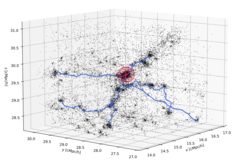The infinitely small or the infinitely large?
Even though her first interest was in the tiny scales of particle physics, Daniela Galárraga-Espinosa decided to go to the other extreme and study galaxies and the large-scale structure of the Universe.
What is your research interest at MPA?

I study galaxies and investigate how the environment, in which they reside, affects their properties. We already know that galaxies form, grow, and evolve in different large-scale structures, such as cosmic filaments, voids, walls and clusters. I want to better understand how these large-scale structures influence the properties of the galaxies, for example their mass, or their ability to form stars. In my work, I analyse the outputs of large numerical simulations (which I consider as true virtual laboratories), and I make theoretical predictions that can help to better interpret real observations.
How did you get interested in galaxies?
During my PhD, I was exploring the physical properties of cosmic filaments in large-scale, hydrodynamical numerical simulations. I realized that the galaxies, which I was using solely to trace the large-scale density field, were in fact altering the properties of the cosmic filaments I was studying. In fact, the many astrophysical processes happening inside them – such as star-formation, feedback from supernovae, and super-massive black holes – can modify the properties and distribution of matter even outside the galaxy. My picture of the Universe at these scales then became more holistic, and I decided to further explore the influence of galactic processes on the cosmic web, and vice-versa.
What made you choose astronomy?
I guess I have always been curious about understanding why things are the way they are. This led me to study fundamental physics in University (Paris-Saclay, France).
At first, it was not clear to me, in what field I should specialize. The ‘’God particle’’ (the Higgs boson) had just been discovered at CERN, so my attention was captured by particle physics, i.e. physics at the infinitely small scales. However, when I did some internships in experimental and theoretical particle physics, I did not like it all that much.
It was only during the last year of my Master that I discovered my passion for cosmology and the physics of the infinitely big. Since then, the choice of career and research topic has come naturally, and I did not think twice about doing a PhD on the study of cosmic filaments, one of the largest-scales structures of the universe.
How do you like MPA and Munich?
The diversity of profiles we have at MPA, regarding both scientific and personal aspects, is great! I enjoy very much learning about topics that are far away from my own research, such as the physics of stars, or exotic models to describe the Universe. But most of all, I feel extremely lucky to be able to interact with people from everywhere in the world, to learn about other cultures, share food, music.
Munich is a big city – with many concerts, festivals, etc. – with the advantages of a small town: you can walk or bike anywhere in a reasonable amount of time. But most of all, I enjoy the proximity with nature, the mountains and lakes, and the big parks inside the city. I often go hiking in the Alps with friends.
Do you have other hobbies?

Dancing. Since I can remember, I have always danced as an extracurricular activity. During high school in Ecuador, I was training in ballet and contemporary dance for three hours every day. In fact, this was one of the hardest choices I had to make as a teenager: Do I stay in my country and try to have a career as a professional dancer, or do I go to France and study sciences? My parents were relieved with the choice I made! 😉
Now, I manage to keep dancing at least two hours per week, and I enjoy exploring new styles!













